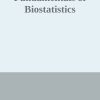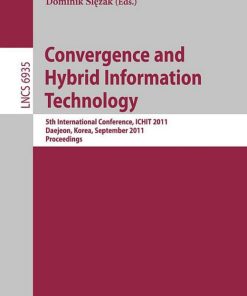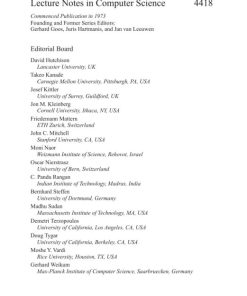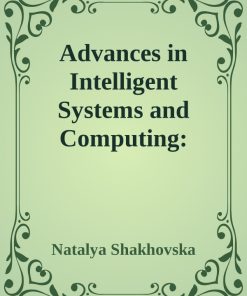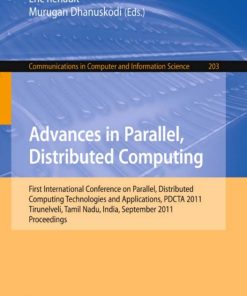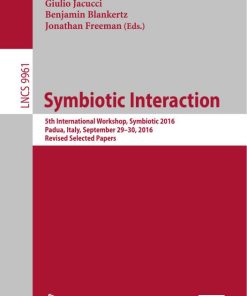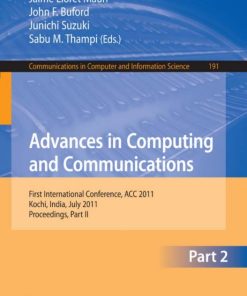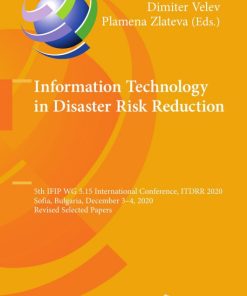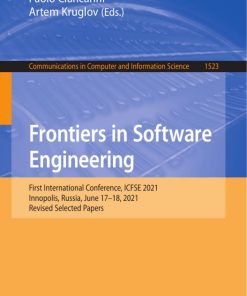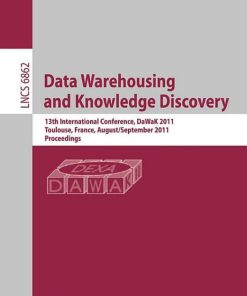E Technologies Transformation in a Connected World 5th International Conference MCETECH 2011 Les Diablerets Switzerland January 2011 Revised Selected Papers 1st Edition by Gilbert Babin, Katarina Stanoevska Slabeva, Peter Kropf ISBN 3642208622 9783642208621
$50.00 Original price was: $50.00.$25.00Current price is: $25.00.
Authors:Gilbert Babin, Katarina Stanoevska-Slabeva, Peter Kropf , Tags:Springer 2011 , Author sort:Gilbert Babin, Katarina Stanoevska-Slabeva, Peter Kropf , Ids:3642208614 , Languages:Languages:eng
E Technologies Transformation in a Connected World 5th International Conference MCETECH 2011 Les Diablerets Switzerland January 2011 Revised Selected Papers 1st Edition by Gilbert Babin, Katarina Stanoevska Slabeva, Peter Kropf – Ebook PDF Instant Download/Delivery. 3642208622, 9783642208621
Full download E Technologies Transformation in a Connected World 5th International Conference MCETECH 2011 Les Diablerets Switzerland January 2011 Revised Selected Papers 1st Edition after payment
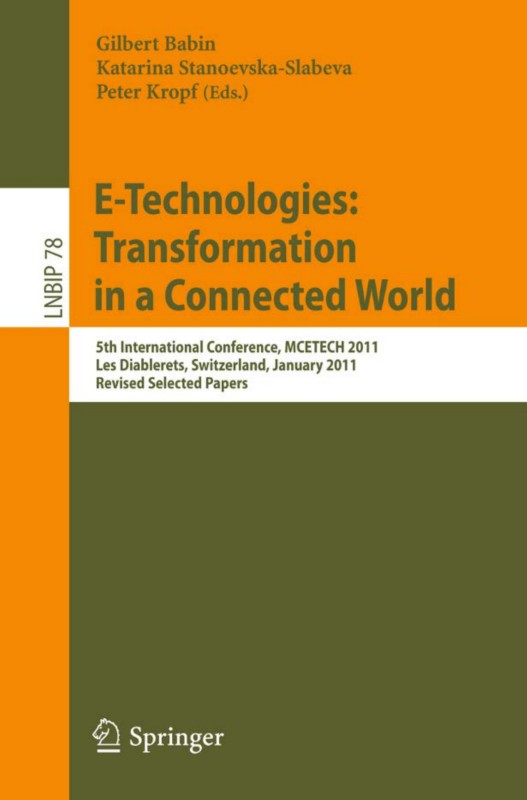
Product details:
ISBN 10: 3642208622
ISBN 13: 9783642208621
Author: Gilbert Babin, Katarina Stanoevska Slabeva, Peter Kropf
This volume constitutes the proceedings of the 5th International Conference on E-Technologies, MCETECH 2011, held in Les Diablerets, Switzerland, January 23-26, 2011. Originally 10 papers were selected from a total of 32 submissions. Seven additional papers were included following a second round of reviewing and improvement.The papers in this volume cover topics such as process modeling, organizational transformation, e-Business, e-Government, e-Education, and e-Health.
E Technologies Transformation in a Connected World 5th International Conference MCETECH 2011 Les Diablerets Switzerland January 2011 Revised Selected Papers 1st Table of contents:
Session 1: Organizational Transformation and Process Adaptation
A Systematic Approach to Web Application Penetration Testing Using TTCN-3
Introduction
Background and Related Work
Problem Description
Specification of Test Oracles in TTCN-3
Test Oracle Self-defining Principle
Sharing Test Oracles among Actors
Re-usability of the Test Suite
A Proposed Refinement to the TTCN-3 Model Architecture
Conclusions
References
Towards Model-Based Support for Managing Organizational Transformation
Introduction
Baseline
Managing the Strategic Initiative Lifecycle
Case Study: Reducing Antibiotic Resistant Infections
Modeling Strategic Initiatives with BIM
Data Mappings in CIM and BIM
Related Work
Evaluation
Conclusions and Future Work
References
Cloud Computing Providers: Characteristics and Recommendations
Introduction
Cloud Computing
Defining Cloud Computing
Classifications of Cloud Computing
Market of Cloud Computing
Cloud Computing Providers
Cloud Computing Consumers
Cloud Computing Risks
Conclusions
References
Session 2: eHealth, eEducation, and eGovernment I
Evolution of Goal-Driven Pattern Families for Business Process Modeling
Introduction
Background
User Requirements Notation (URN)
Patterns
Goal-Oriented Pattern Family Framework (GoPF)
Evolution of Goal-Driven Pattern Family
Patient Safety Example
Family Creation (GDM-FDM)
Customization (GDM-OCEM)
Family Evolution (GDM-FDM)
Applying the Extension Algorithm
Related Work
Conclusions and Future Work
References
Searching, Translating and Classifying Information in Cyberspace
Introduction
Search Technologies
Machine Translation
Automatic Classification in the Blogosphere
Conclusion
References
E-Tourism Portal: A Case Study in Ontology-Driven Development
Introduction
UNCTAD’s E-Tourism Initiative
ETP: The High-Level Architecture
The E-Tourism Ontology
Why a Tourism Ontology
The ETP Ontology Design Process
The eTP Ontology
ETP: An Ontology-Driven E-Tourism Portal
Data Collector
Content Management: OpenCms
Publication
Discussion
Lessons Learned
Related Work
Conclusion
References
Session 3: Process Modeling
Toward a Goal-Oriented, Business Intelligence Decision-Making Framework
Introduction
Background Review
BI-Based Decision Making
Goal-Oriented Requirement Language
GRL and KPI for Business Modeling
New Formula-Based Evaluation Algorithm
Business Intelligence Decision-Making Framework
Retail Business Real-Life Example
Lessons Learned
Conclusions
References
SoftwI re Integration – An Onto-Neural Perspective
IT Landscapes and Challenges
The Onto-Neural Approach to Integration
Integration Method: Functional Design
Integration Framework: Technical Design
Ontology Building
Comparing Ontologies through Neural Networks
The Integration Script (Step 6)
Related Work
Conclusion
References
Session 4: Novel Development Technologies
Flexible Communication Based on Linguistic and Ontological Cues
Introduction
Overall Approach
Multi-agent Platform
Digital Butler Architecture
The 2-step Approach
Ontology and KB Formalism
The MOSS Representation Language
Sharing Ontologies
Selecting an Action (PA)
The Library of Tasks
The Selection Mechanism
Sending Information to the Staff Agents
Interpreting the Data (Staff Agent)
Global Approach
Types of Requests
Mechanism
Adding Information
The HDSRI Example
Simple Email Request
More Complex Requests
Discussion, Limits and Further Work
Relevant Works
References
Decentralized Task Allocation Mechanism Applied to QoS Routing in Home Network
Introduction
Problem Overview
Agent-Based Solution
Knowledge Plane
Ginkgo Multi Agent System
Task Allocation in Home Network
Motivation
Formalization
Environment
Approach and General Principles
Application
Conclusion and Future Works
References
Session 5: eHealth, eEducation, and eGovernment II
A Study of E-Government Architectures
Introduction
A Sample of E-Government Architectures
Comparison of the Architectures Sample
Principle Features (Attributes) of an E-Gov Architecture
Conclusion
References
Model-Based Engineering of a Managed Process Application Framework
Introduction
Background
Model Driven Engineering and Application Frameworks
Service Oriented Architecture
Integrated Data Management
Engineering a Palliative Care Managed Process Application
PAL-IS Implementation
AndroMDA Implementation
MPAF Implementation
Managed Process Application Framework
Application Run-Time Processing
Example Model Definitions
Evaluation
Conclusions
References
Session 6: Internet-Based Collaborative Work
Harnessing Enterprise 2.0 Technologies: The Midnight Projects
Enterprise 2.0
The Context of the Midnight Projects
Developing the Skills for Successful Enterprise 2.0 Strategies
Building a Roadmap to Link Enterprise 2.0 Technologies to Strategy
Establishing the Metrics to Judge Success
The Impact of Enterprise 2.0 on Business Practice
References
Following the Conversation: A More Meaningful Expression of Engagement
Introduction
Related Work
Background
Data and Methodology
Results
Conclusion
References
The Design, Development and Application of a Proxy Credential Auditing Infrastructure for Collaborat
Introduction
PCA Software Architecture
Auditing Events
Auditing Event Emitters
Credentials
External Interface
Analysis
Implementation
Events
Event Emitters
Public Interface
DAMES Case Study
Future Work
References
Session 7: eBusiness
Towards Detecting Influential Users in Social Networks
Introduction
Influence Measurement Techniques
Model for Interaction-Based Influence Measurement
Indegree and Outdegree Centrality
Link Strength
Incoming and Outgoing Clustering Value
Calculating Influence
Implementation
Conclusion
References
Intelligent Monitoring System for Online Listing and Auctioning
Introduction
Motivation
History of Illegal Auctions
Intelligent Monitoring System
Data Gathering and Generation
Bag-of-Words Model
Naive Bayes Classifier
Experimental Results
Data Set
Introduction to WEKAweka011
Discussion
Results
Related Works
Conclusion and Future Work
References
Invited Papers
Gossip-Based Networking for Internet-Scale Distributed Systems
Introduction
Challenges in Massive-Scale Distributed Systems
Outline
Gossiping Protocols: From Traditional to Modern
Clearinghouse: Synchronization of Database Replicas
Today’s Challenges
The Gossiping Framework
Further Reading
Random Overlays
The Newscast Protocol
The Cyclon Protocol
Properties
Further Reading
Structured Overlays
Test Case: Interest-Based Overlays
Further Reading
Overlay Slicing
Further Reading
Distributed Aggregation
Decentralized System Size Estimation Using Aggregation
The Many Other Uses of Gossip-Based Networking
Self-organizing Publish and Subscribe
Taming Networked Systems Complexity
Gossip-Based Networking and Security Aspects
People also search for E Technologies Transformation in a Connected World 5th International Conference MCETECH 2011 Les Diablerets Switzerland January 2011 Revised Selected Papers 1st :
e-technologies: transformation in a connected world
technological transformations
technology transformed
digital transformation in engineering
a connected world


